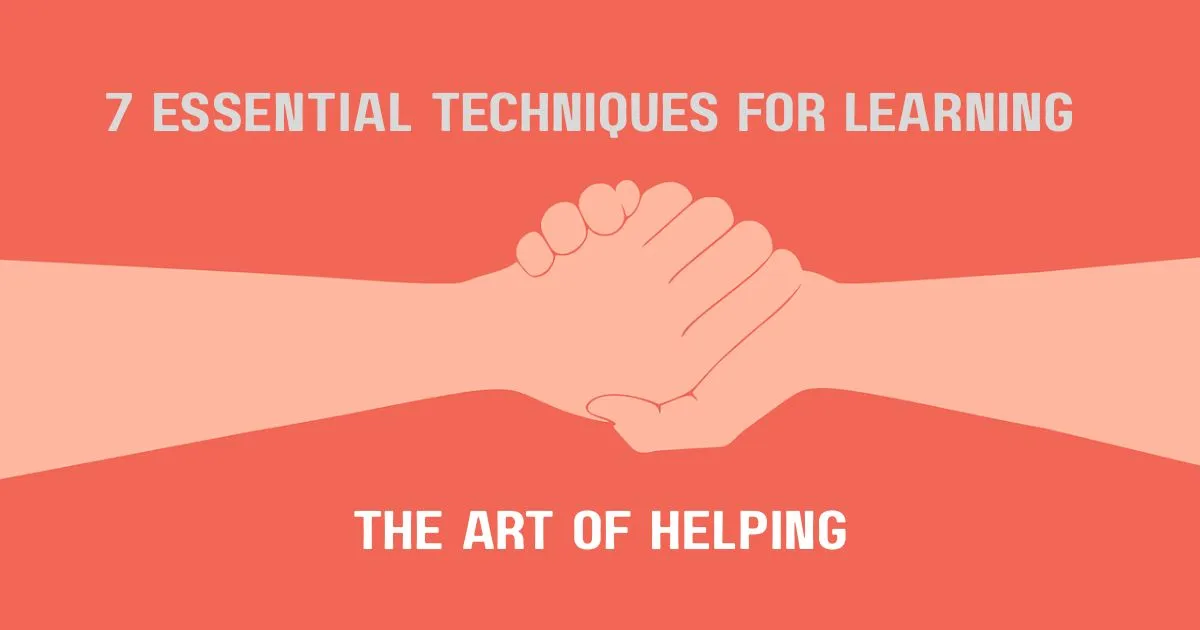Introduction: The Power of Helping Others
The art of helping is one of life’s most rewarding experiences. Whether offering a listening ear, providing practical support, or simply being present for someone in need, mastering this art strengthens relationships, fosters personal growth, and creates a more compassionate world.
But helping isn’t just about good intentions; it’s an art that requires skill, empathy, and emotional intelligence. When done right, it can transform lives, including your own. In this guide, we’ll explore 7 essential techniques for learning the art of helping so you can support others in a meaningful, respectful, and truly impactful way.
1. Practice Active Listening
One of the most powerful ways to help someone is simply to listen, truly listen. Active listening means giving your full attention, without interrupting or planning your response while the other person is speaking. It’s about being present and making the speaker feel heard and valued.
To practice active listening:
Maintain eye contact and nod to show engagement.
Reflect what you hear (“It sounds like you’re feeling overwhelmed”).
Avoid jumping in with advice unless asked.
When people feel truly listened to, they often find their solutions, and your supportive presence alone can be a tremendous help.
2. Cultivate Empathetic Communication
Empathy is the ability to understand and share another person’s feelings. Empathetic communication goes beyond sympathy (“I feel sorry for you”) and instead says, “I’m here with you.” This builds trust and deepens connections.
For example, if a friend is stressed about work, instead of saying, “You’ll be fine,” try
“That sounds tough. How can I support you?”
“I can see why you’d feel that way.”
Empathy validates emotions and helps others feel less alone in their struggles.
3. Offer Practical Support (Not Just Words)
Sometimes, people need more than encouragement; they need action. Effective helping means identifying when someone could benefit from practical assistance and offering it in a way that respects their autonomy.
For instance:
Instead of saying, “Let me know if you need anything,” try, “Can I pick up groceries for you this week?”
Help with specific tasks, like babysitting, running errands, or assisting with a project.
This approach removes the burden of asking and shows you genuinely care.
4. Develop Emotional Intelligence
Emotional intelligence (EQ) is the ability to recognize and manage your own emotions while understanding others’. High EQ helps you respond to people’s needs with sensitivity and insight.
Ways to improve your EQ:
Pay attention to body language and tone.
Practice self-awareness and notice how your emotions affect your responses.
Stay calm and patient, even in emotionally charged situations.
The better you understand emotions, the more effectively you can help.
5. Respect Boundaries
Helping doesn’t mean overstepping. People have different comfort levels when it comes to receiving support, and pushing too hard can backfire. Respecting boundaries ensures your help is welcome, not intrusive.
How to maintain healthy boundaries:
Ask permission before offering advice.
Accept that if someone declines help, don’t take it personally.
Recognize when professional help (like therapy) is needed.
True support empowers, not overwhelms.
6. Encourage Self-Empowerment
The best help enables others to help themselves. Instead of solving problems for people, guide them toward their solutions. This builds confidence and independence.
Try phrases like
“What do you think would help in this situation?”
“You’ve handled tough things before. What worked then?”
This approach fosters resilience and long-term growth.
7. Lead with Kindness and Patience
Helping isn’t always easy. Some situations require time, and progress may be slow. Kindness and patience ensure your support remains steady and nonjudgmental.
Remember:
Small gestures (a text, a smile) can mean a lot.
Avoid frustration if someone doesn’t change immediately.
Celebrate small victories together.
Your consistent care can make all the difference.
Conclusion: Start Helping with Heart
Learning the art of helping is a journey that deepens your connections and enriches your own life as much as others’. By practicing these 7 essential techniques, from active listening to emotional intelligence, you’ll become a more effective, compassionate supporter.
Now, take the first step. Who in your life could use a little extra support today? Reach out, listen deeply, and offer your help with an open heart. The world needs more people like you.
FAQ: Learning the Art of Helping
1. What is “Learning the Art of Helping: Building Blocks and Techniques”?
“Learning the Art of Helping: Building Blocks and Techniques“ refers to a systematic approach to developing essential helping skills. The 7th Edition of this framework emphasizes practical techniques like active listening, emotional intelligence, and boundary-setting to create meaningful support.
2. How is the 7th Edition different from previous versions?
The 7th edition expands on:
Neuroscience-backed empathy tools
Digital-era communication strategies
Self-care practices for helpers
Think of it as a modern toolkit for today’s challenges.
3. Can anyone master the art of helping?
Absolutely! While some people are natural helpers, these skills can be learned. The Building Blocks and Techniques approach breaks it down into actionable steps anyone can practice daily.
4. What’s the most overlooked technique in the 7th Edition?
“Silent support”—sometimes presence speaks louder than advice. The 7th Edition dedicates a full chapter to non-verbal helping strategies.
5. How long does it take to see results?
Most people notice improved relationships within 2-3 weeks of consistent practice. Mastery deepens over months as techniques become second nature.
6. Where can I apply these techniques?
Everywhere! From workplaces (manager-employee dynamics) to personal relationships (parenting, friendships). The 7th Edition includes tailored scenarios for each setting.
7. Is there a risk of over-helping?
Yes, that’s why the 7th Edition emphasizes “helping with healthy boundaries.” It teaches how to support others without burnout.

